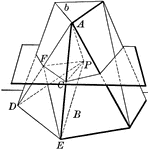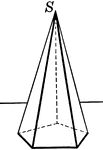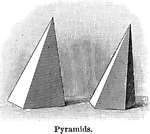
Prismatoid Illustration for Volume
Illustration to show how volume of a prismatoid is found. "The volume of a prismatoid is equal to the…

2 Octagonal Prisms
Illustration of 2 right octagonal prisms with congruent bases, but different heights. The height of…

2 Rectangular Prisms
Illustration of 2 right rectangular prisms. The bases are congruent, but the height of the smaller prism…

2 Rectangular Prisms
Illustration of 2 right rectangular prisms. The bases are congruent, but the height of the smaller prism…
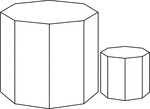
2 Similar Octagonal Prisms
Illustration of 2 Similar right octagonal prisms. The height and length of the edges of the smaller…
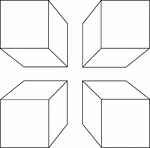
4 Congruent Rectangular Prisms
Illustration of 4 congruent rectangular prisms placed in the shape of a square. They are arranged to…

Equal Prisms
Illustration showing two prisms are equal if the three faces which include a trihedral angle of the…

Similar Decagonal Prisms
Illustration of 2 similar right decagonal prisms. Both have regular decagons for bases and rectangular…
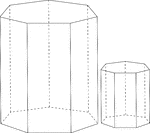
Similar Heptagonal/Septagonal Prisms
Illustration of 2 similar right heptagonal/septagonal prisms. Both have regular heptagons/septagons…

Similar Hexagonal Prisms
Illustration of 2 similar right hexagonal prisms. The height of the prism and length of the side of…

Similar Hexagonal Prisms
Illustration of 2 similar right hexagonal prisms. The height of the prism and length of the side of…

Decagonal Pyramid
Illustration of a right decagonal pyramid. The base is a decagon and the faces are isosceles triangles.…

Frustum Pyramid
The frustum of a pyramid is the portion of a pyramid included between the base and a section parallel…

Frustum Pyramid for Volume
The volume of the frustum of any pyramid is equal to the sum of the volumes of three pyramids whose…
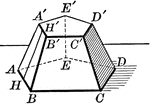
Frustum of a Regular Pyramid With Pentagonal Base
Illustration of a regular pyramid with a pentagon for a base.
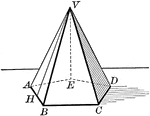
Frustum of Pentagonal Pyramid
The frustum of a pentagonal pyramid is the portion of a pyramid included between the base and a section…

Hexagonal Pyramid
Illustration of a right hexagonal pyramid with hidden edges shown. The base is a hexagon and the faces…
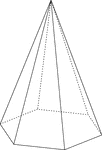
Hexagonal Pyramid
Illustration of a right hexagonal pyramid with hidden edges shown. The base is a hexagon and the faces…
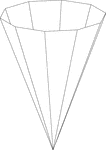
Inverted Decagonal Pyramid
Illustration of a hollow right decagonal pyramid. The base is a decagon and the faces are isosceles…
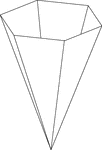
Inverted Hexagonal Pyramid
Illustration of a hollow right hexagonal pyramid. The base is a hexagon and the faces are isosceles…

Inverted Nonagonal Pyramid
Illustration of a hollow right nonagonal pyramid. The base is a nonagon and the faces are isosceles…
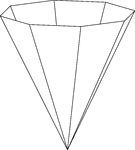
Inverted Octagonal Pyramid
Illustration of a hollow right octagonal pyramid. The base is an octagon and the faces are isosceles…

Inverted Rectangular Pyramid
Illustration of a hollow right rectangular pyramid. The base is a rectangle and the faces are isosceles…
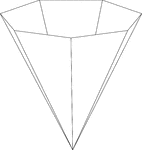
Inverted Septagonal/Heptagonal Pyramid
Illustration of a hollow right heptagonal (septagonal) pyramid. The base is a heptagon and the faces…
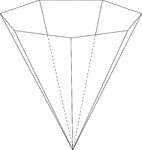
Inverted Septagonal/Heptagonal Pyramid
Illustration of a hollow right heptagonal (septagonal) pyramid. The base is a heptagon and the faces…

Nonagonal Pyramid
Illustration of a right nonagonal pyramid with hidden edges shown. The base is a nonagon and the faces…
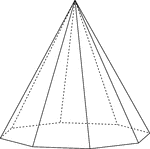
Octagonal Pyramid
Illustration of a right octagonal pyramid with hidden edges shown. The base is an octagon and the faces…

Pentagonal Pyramid
Illustration of a right pentagonal pyramid with hidden edges shown. The base is an pentagon and the…
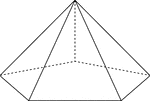
Pentagonal Pyramid
Illustration of a right pentagonal pyramid with hidden edges shown. The base is an pentagon and the…
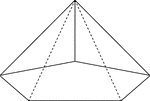
Pentagonal Pyramid
Illustration of a right pentagonal pyramid viewed from below with hidden edges shown. The base is an…
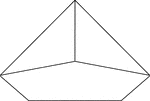
Pentagonal Pyramid
Illustration of a right pentagonal pyramid viewed from below. The base is an pentagon and the faces…

Pentagonal Pyramid For Volume
Illustration of pentagonal pyramid used to show that the volume is equal to one third of the product…
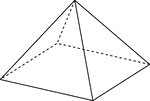
Rectangular Pyramid
Illustration of a right rectangular pyramid with hidden edges shown. The base is a rectangle and the…

Rectangular Pyramid
Illustration of a right rectangular pyramid with hidden edges shown. The base is a rectangle and the…
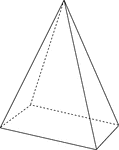
Rectangular Pyramid
Illustration of a right rectangular pyramid with hidden edges shown. The base is a rectangle and the…
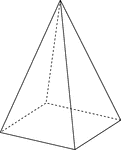
Rectangular Pyramid
Illustration of a right rectangular pyramid with hidden edges shown. The base is a rectangle and the…

Septagonal/Heptagonal Pyramid
Illustration of a right septagonal/heptagonal pyramid with hidden edges shown. The base is a heptagon…

Skewed Hexagonal Pyramid
Illustration of a non-right, or skewed, hexagonal pyramid with hidden edges shown. The base is a hexagon…

Skewed Rectangular Pyramid
Illustration of a non-right, or skewed, rectangular pyramid with hidden edges shown. The base is a rectangle…

Triangular Pyramid For Volume
Illustration of triangular pyramid used to show that the volume is the limit of the sum of the volumes…
Triangular Pyramid For Volume
Illustration of triangular pyramid used to show that the volume is equal to one third of the product…

2 Right Pentagonal Pyramids
Illustration of 2 right pentagonal pyramids with hidden edges shown. The pentagonal bases are congruent,…
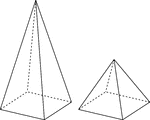
2 Right Rectangular Pyramids
Illustration of 2 right rectangular pyramids with hidden edges shown. The rectangular bases are congruent,…

Equivalent Triangular Pyramids
Two triangular pyramids having equivalent bases and equal altitudes are equivalent.

Pyramids With Pentagonal and Triangular Bases
Illustration of pentagonal and triangular pyramids cut by a plane parallel to the bases.
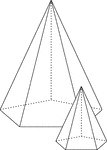
Similar Pentagonal Pyramids
Illustration of 2 similar right pentagonal pyramids with hidden edges shown. The height of the pyramid…

Triangular Pyramids for Volume
Illustration showing that the volume of 2 triangular pyramids, having the same trihedral angle of the…

Rectangular Prism
A rectangular prism with labeled sides: AAAA are the four vertical parallel corners. BBBB and CCCC are…

Rectangular Pyramid Cut By Plane
Illustration of a right rectangular pyramid that has been cut by a plane parallel to the base. The lower…
